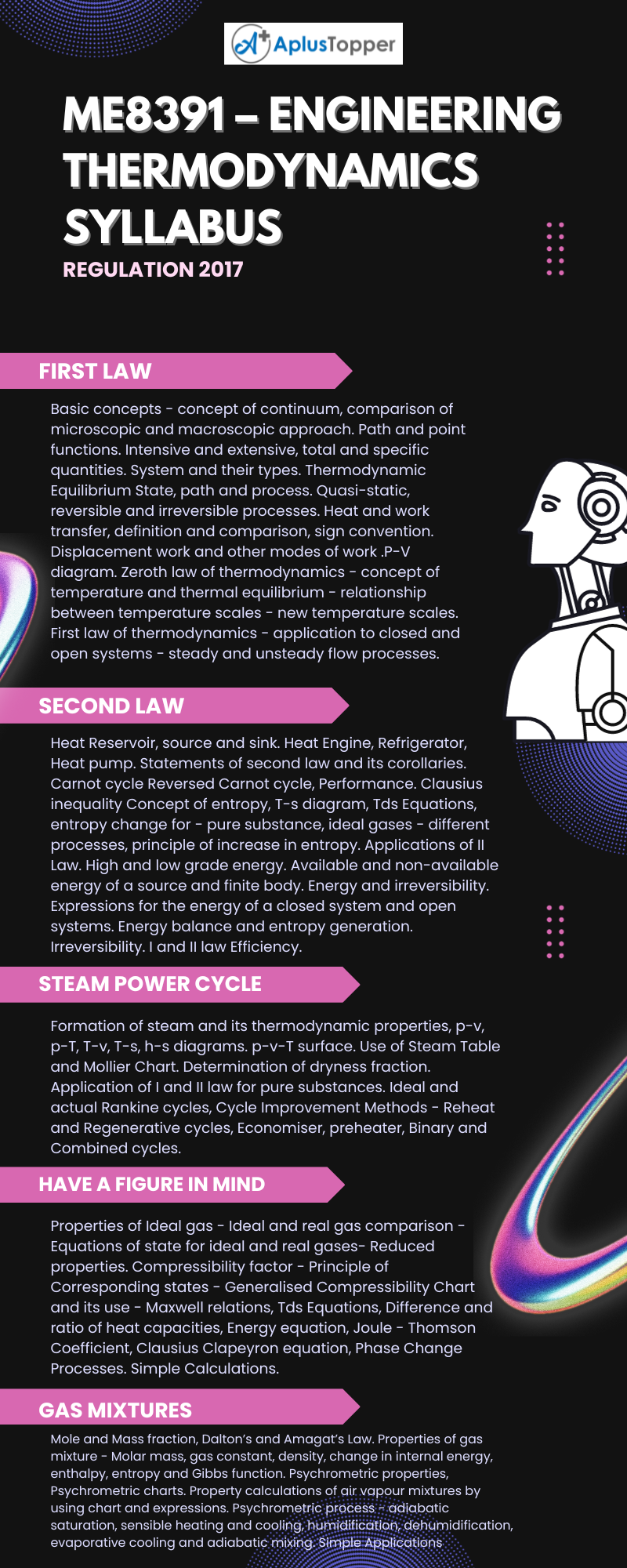Code – ME8391, this article about B.E/B.Tech./B.Arch Mechanical Engineering Semester III Engineering Thermodynamics syllabus. Students are requested to make notes or PDFs of the semester in Engineering Thermodynamics for effective preparation from here. It will help you to understand what are the topics in the syllabus of Engineering Thermodynamics.
And to make preparation strategies to score well in the examinations. Unit-wise detailed syllabus is given below in one place, in the following article ME8391 – Engineering Thermodynamics. If the information helps you, kindly share it with your classmates.
If you want to know more about the syllabus of B.E Mechanical Engineering connected to an affiliated institution’s four-year undergraduate degree programme. We provide you with a detailed Year-wise, semester-wise, and Subject-wise syllabus in the following link B.E Mechanical Engineering Syllabus Anna University Regulation 2017.
Aim Of Concept:
To familiarize the students to understand the fundamentals of thermodynamics and to perform thermal analysis on their behavior and performance. (Use of Standard and approved Steam Table, Mollier Chart, Compressibility Chart, and Psychrometric Chart permitted).
ME8391 – Engineering Thermodynamics Syllabus
Unit I: Basic Concepts And First Law
Basic concepts – concept of continuum, comparison of microscopic and macroscopic approach. Path and point functions. Intensive and extensive, total and specific quantities. System and their types. Thermodynamic Equilibrium State, path and process. Quasi-static, reversible and irreversible processes. Heat and work transfer, definition and comparison, sign convention. Displacement work and other modes of work .P-V diagram. Zeroth law of thermodynamics – concept of temperature and thermal equilibrium – relationship between temperature scales – new temperature scales. First law of thermodynamics – application to closed and open systems – steady and unsteady flow processes.
Unit II: Second Law And Availability Analysis
Heat Reservoir, source and sink. Heat Engine, Refrigerator, Heat pump. Statements of second law and its corollaries. Carnot cycle Reversed Carnot cycle, Performance. Clausius inequality Concept of entropy, T-s diagram, Tds Equations, entropy change for – pure substance, ideal gases – different processes, principle of increase in entropy. Applications of II Law. High and low grade energy. Available and non-available energy of a source and finite body. Energy and irreversibility. Expressions for the energy of a closed system and open systems. Energy balance and entropy generation. Irreversibility. I and II law Efficiency.
Unit III: Properties Of Pure Substance And Steam Power Cycle
Formation of steam and its thermodynamic properties, p-v, p-T, T-v, T-s, h-s diagrams. p-v-T surface. Use of Steam Table and Mollier Chart. Determination of dryness fraction. Application of I and II law for pure substances. Ideal and actual Rankine cycles, Cycle Improvement Methods – Reheat and Regenerative cycles, Economiser, preheater, Binary and Combined cycles.

Unit IV: Ideal And Real Gases, Thermodynamic Relations
Properties of Ideal gas – Ideal and real gas comparison – Equations of state for ideal and real gases- Reduced properties. Compressibility factor – Principle of Corresponding states – Generalised Compressibility Chart and its use – Maxwell relations, Tds Equations, Difference and ratio of heat capacities, Energy equation, Joule – Thomson Coefficient, Clausius Clapeyron equation, Phase Change Processes. Simple Calculations.
Unit V: Gas Mixtures And Psychrometry
Mole and Mass fraction, Dalton’s and Amagat’s Law. Properties of gas mixture – Molar mass, gas constant, density, change in internal energy, enthalpy, entropy and Gibbs function. Psychrometric properties, Psychrometric charts. Property calculations of air vapour mixtures by using chart and expressions. Psychrometric process – adiabatic saturation, sensible heating and cooling, humidification, dehumidification, evaporative cooling and adiabatic mixing. Simple Applications
Text Books:
- R.K.Rajput, “A Text Book Of Engineering Thermodynamics “,Fifth Edition,2017.
- Yunus a. Cengel & michael a. Boles, “Thermodynamics”, 8th edition 2015.
References:
- Arora C.P, “Thermodynamics”, Tata McGraw-Hill, New Delhi, 2003.
- Borgnakke & Sonnatag, “Fundamental of Thermodynamics”, 8th Edition , 2016.
- Chattopadhyay, P, “Engineering Thermodynamics”, Oxford University Press, 2016.
- Michael J. Moran, Howard N. Shapiro, “Fundamentals of Engineering Thermodynamics”, 8th Edition.
- Nag.P.K., “Engineering Thermodynamics”, 5th Edition, Tata McGraw-Hill, New Delhi, 2013.
If you want to check the syllabus of other branches provided by Anna University, Anna University syllabus Regulation 2017 will assist you in a clear path. Hope you find the required details.
Related Posts Of Semester – III:
- MA8353 – Transforms and Partial Differential Equations Syllabus
- CE8394 – Fluid Mechanics and Machinery Syllabus
- ME8351 – Manufacturing Technology – 1 Syllabus
- EE8353 – Electrical Drives and Controls Syllabus
- ME8361 – Manufacturing Technology Laboratory -1 Syllabus
- ME8381 – Computer Aided Machine Drawing Syllabus
- EE8361 – Electrical Engineering Laboratory Syllabus
- HS8381 – Interpersonal Skills/Listening & Speaking Syllabus
